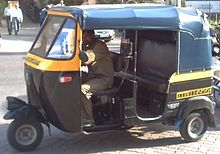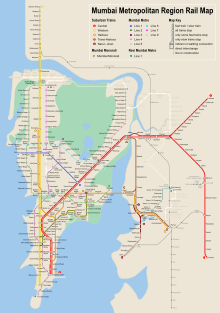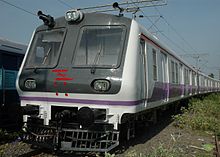Transport in Mumbai


Transport in Mumbai is achieved by both public and private transport. As of 2016, 52% of commuters use public transport.[1] Mumbai has the largest organized bus transport network among major Indian cities.
Mumbai's public transport consists primarily of rapid transit on exclusive suburban railway lines augmented by commuter rail on main lines serving outlying suburbs, the bus services of the three municipalities making up the metropolitan area, public taxis and auto rickshaws, as well as ferry services. A metro and a monorail system were inaugurated in 2014. A commercial seaplane service was also introduced in 2014.[2]
Road
[edit]Sea-links
[edit]As of 2024, Mumbai currently has 3 major operational or under construction sea-links:
The Bandra–Worli Sea Link bridge is one of the longest bridges in the country, opened in 2009. It connects the suburbs of Bandra and Worli, and carries around 32,000 vehicles daily as of 2018.[3]
The Trans Harbour Link is the longest bridge in India. It was opened on 12 January 2024, when Prime Minister Narendra Modi inaugurated the bridge. It connects Mumbai with Navi Mumbai and is 21.8 kilometers in length. The bridge runs between the localities of Sewri in South Mumbai to Ulwe of Navi Mumbai.[4][5]
The Coastal Road (officially the Chhatrapati Sambhaji Maharaj Coastal Motorway) is an under construction 8-lane, 29.2-km long expressway that will run along Mumbai's western coastline. It will connect the locality of Marine Lines in the south to Mumbai and Kandivali in the North. It is projected to be used by 130,000 vehicles daily and to reduce travel time between South Mumbai and the Western Suburbs from 2 hours to 40 minutes. Its first phase was inaugurated on 11 March 2024.[6]
Buses
[edit]

- Brihanmumbai Electric Supply and Transport (BEST) has a fleet of single, double decker buses and air-conditioned Tata Marcopolo CNG mini buses. BEST runs their buses in Mumbai and its surrounding area.
- Navi Mumbai Municipal Transport (NMMT) operates air-conditioned Volvo buses from Navi Mumbai to Bandra, Dadar, Mantralaya & Borivali and non A/C buses from Navi Mumbai to Mulund, Kurla, Dadar, Andheri, Dindoshi & Mantralaya.
- Thane Municipal Transport (TMT) operates buses from Thane to Mulund, Borivali, Mira Road, BKC & Andheri.
- Mira-Bhayandar Municipal Transport (MBMT) operates buses from Mira-Bhayandar to Andheri, Thane and Borivali.
Taxis
[edit]


Taxis arrived in 1911 to complement horse cars. Black and yellow Fiat taxis are an integral part of the city's heritage and have been depicted in numerous Bollywood movies. Metered taxis ply throughout Mumbai and have a monopoly from Bandra to Churchgate on the Western line and Sion to Chatrapati Shivaji Terminus on the Central line. Beyond Sion and Bandra auto rickshaws are not allowed and one has to hire a taxi. However, between Sion to Thane and Bandra to Bhayandar, both Taxis and autorickshaws are available to transport passengers.
- Silver-Green taxis run by Meru and Yellow-Red by Gold cabs and Black by Mega Cabs
- Blue and silver air-conditioned metered taxis known as "Cool Cabs"
- Some private taxi operators provide yellow number plate cars for transportation
Mumbai is served by two intra-city highways: Old Mumbai-Pune Highway and Mumbai-Ahmedabad Highway.
Number of taxis
[edit]There are around 58,000 taxis in Greater Mumbai and 98,566 in Mumbai MMR as of 2010.[7]
Classic black and yellow taxi numbers on Greater Mumbai roads had fallen to 20,000 by 2010,[8] as 35,000 new taxis such as Maruti Alto, Wagon R and Omni, Tata Indica and Hyundai Santro had entered service. Recently State Transport Authority of Maharashtra State has also introduced the on-call facility to book these taxis.
Taxi Regulations
[edit]Law requires the driver of an unengaged taxi to take a passenger wherever they want to go, regardless of distance or time, if the fare meter of the unengaged rickshaw/taxi is in a 'For Hire' mode. The modes were denoted by older mechanical meters in this manner: a) upright – for hire b) half mast – not doing business c) facing down-currently hired.
Authorities encourage passengers to make complaints, for refusal to convey, excess fare, tampered meters, fake tariff cards, misconduct by drivers by direct email[9][10][11][12] as well as by a website.[13]
Rickshaws
[edit]
Auto rickshaws play an important role in public transport in Mumbai. There are 246,458 black and yellow metered auto rickshaws, often simply called autos, in the Mumbai MMR as of 2008.[7] Since 2002, all auto rickshaws have been required to use CNG as fuel.[14] However, not all rickshaws comply. In some areas if a CNG filling facility is not available, the fuel is either petrol or LPG.
Auto rickshaws are not permitted to enter Old Bombay. The southernmost points accessible to them are Bandra Fire Station in Western Mumbai and Sion Bus Depot in Central Mumbai. Auto rickshaws registered in Mumbai are not allowed travel beyond the municipal limits. They have been allowed to travel between Sion to Mulund in the Central Suburbs and up to Mankhurd on the Harbour line. People who wish to travel beyond Mumbai to suburbs like Vashi, Airoli have to catch a suburban rickshaw. In the western suburbs, they are allowed to travel between Bandra and Bhayandar only.
A mechanical meter decides the fare which is proportional to distance traveled. The Mumbai Metropolitan Region Transport Authority (MMRTA) updated the auto-rickshaw fares and declared a hike recently that is applied from 1 March 2021.[15] The regulation for auto rickshaws is similar to taxis, and methods of complaining against the auto rickshaws and taxis are available on the Mumbai RTO website.[16]
Survey
[edit]In 2021, UK-based car-sharing company Hiyacar has announced in a survey that Mumbai is the most stressful city in the world for driving.[17] Public transportation options are one of the main factors which were observed for the survey.[18]
Rail
[edit]
Mumbai Suburban Railway
[edit]
The Mumbai Suburban Railway is the oldest commuter rail in Asia, founded in 1853.[19] It is owned by Indian Railways and operated by its Western Railways and Central Railways divisions. Most economical transport subsidized by the government of India via Railway ministry. With a length of 430 km, it has highest passenger density in the world, 7.5 million people daily, more than half of daily capacity of Indian Railways.[20] It has four radial lines:
- Western between Churchgate and Dahanu Road
- Central between Chatrapati Shivaji Terminus (CST) and Kasara/Khopoli
- Harbour, running between CST and Panvel/Goregaon
- Trans-Harbour, running between Thane and Vashi/Panvel
Mumbai railways offer first class commuter transport. First class fares are approximately 10 times the second class fare[21] and tend to be less crowded in the non-rush hour period. First class compartments also have slightly better seats than second class. While less crowded during non-peak hours, the first class compartments are rather more crowded during the peak hour time, as there is a large supply and demand gap. It is notoriously hard to get into the first class compartment as the coach is overcrowded with people hanging out of the doors.[citation needed]
Since 2017, Mumbai Suburban Rail became the first in India to operate Air-Conditioned rakes in its Western and Central line. These rakes are equipped with automatic doors and are vestibuled in a 12-coach configuration with coaches 1 to 6 vestibuled, motor connection between coaches 6 and 7 and coaches 7 to 12 again vestibuled.
There are also women-only cars (termed 'ladies'),[21] and since 1992, 'Ladies Special' trains with all coaches reserved for women passengers.[22]
Metro
[edit]
In January 2004, a master transit plan was unveiled by the Mumbai Metropolitan Region Development Authority (MMRDA). The plan integrated a 146 kilometer-long metro system, of which 32 km would be underground.
In June 2004, government approval was given for a 12-station elevated line between Ghatkopar and Versova. In June 2006, the first phase of the Mumbai Metro project was inaugurated. Construction work began in February 2008.[23][24][25] A successful trial run was conducted in May 2013, and the system's first line entered operation in June 2014,[26][27][28] although some aspects of the project were afflicted by delays and cost issues.[24][29][30][31] The Mumbai Metro opened on 8 June 2014. On 2 April 2022, Metro line 2A and 7 were inaugurated, these two lines have a combined length of 19,25 km and will reduce the traffic congestion in North Mumbai.
Many more lines are under-construction or planned having a total length of 345 km (215 mi).
Monorail
[edit]
The Mumbai Monorail is a monorail system for the city of Mumbai. Construction began in January 2009 and the first operational line was inaugurated on 1 February 2014.[32][33] It is being contracted by the Mumbai Metropolitan Region Development Authority and is the first monorail in India.[34]
Four lines were proposed. The first two are 25 kilometres (16 mi) long. Out of the two, Line 1 was opened to the public in 2014.
- Initial plans were to build a line running from Malabar Hill to the Bandra-Kurla complex via the Haji Ali Dargah, Jacob Circle, Wadala Road, Sion Hospital and Dharavi. This was planned to have been opened by 2011.
- A line from Thane to Bhiwandi via Kalyan. A consultant's report to government has recommended that this corridor be served instead by a road-based system for the next 10–15 years using buses and bus rapid transit.[35]
Two lines 10 kilometres (6.2 mi) long were to be constructed after the first two have opened.
- Chembur to Jacob Circle via Mahul. This route is planned to have been opened by December 2010.[36] (May get extended to Vashi, Navi Mumbai.)
- Lokhandwala Complex to Kanjurmarg via Oshiwara.
Additionally, previously planned Mumbai Metro corridors are also being examined to be made as monorail corridors instead of the metro by MMRDA due to the dense and congested areas these corridors pass through. The corridors are:
- Hutatma Chowk – Ghatkopar – 21.8 km
- Ghatkopar – Mulund – 12.4 km
Bullet Train
[edit]The 650 km Mumbai-Ahemdabad Bullet train project is another major high-speed rail project that is supposed to run between Mumbai and Ahemdabad is poised to revolutionize travel time between these two major cities which usually would take about 7 to 8 hours to a meager 2hrs 57mins.This would create demand for real estate in key areas such as Thane, Dombivali and Kalyan.[37]
Trams
[edit]Trams were an important form of transport until the mid-1960s. They were introduced in the late 19th century and in their heyday, covered many areas of the city. At their peak, route length grew to more than 47 kilometers. The system closed down in 1964.[38]
Ferry
[edit]
- from Vashi (in Navi Mumbai) to the Gateway of India
- to Elephanta Caves and to nearby places such as Alibaug, Rewas, and Mandwa
- in northern Mumbai across the Manori Creek. The barges operate at regular intervals across the shallow creek linking Manori to Malad
- from Versova to Madh Island
Air
[edit]
The Chhatrapati Shivaji Maharaj International Airport (formerly Sahar International Airport) is the main aviation hub in the city and the second busiest airport in India in terms of passenger traffic.[39] It handled 30.74 million passengers and 656,369 tonnes of cargo during FY 2011–12.[citation needed]
The new integrated terminal T2 was inaugurated on 10 January 2014[40] and opened for international operations on 12 February 2014, increasing the capacity of the airport to 40 million passengers annually.[41] A dedicated six lane, elevated road connecting the new terminal with the main arterial Western Express Highway was also opened to the public the same day.[42]
The proposed Navi Mumbai International Airport to be built in the Kopra-Panvel area has been sanctioned by the Indian Government and will help relieve the increasing traffic burden on the existing airport.
The Juhu Aerodrome was India's first airport, and now hosts a flying club and a heliport.[43]
See also
[edit]References
[edit]- ^ Rao, KV Krishna. "TOWARDS BETTER ACCESSIBILITY AND MOBILITY IN INDIAN CITIES" (PDF).
- ^ "Mumbai's first Commercial Seaplane Service to takeoff today". news.biharprabha.com. Indo-Asian News Service. Retrieved 24 February 2014.
- ^ Sharma, R (30 April 2018). "Bandra-Worli sea link: Traffic falls 13% in 2017-18". The Financial Express. Archived from the original on 5 May 2023. Retrieved 7 May 2024.
- ^ "Speed limit 100 km/h, no bikes and autos: All about India's longest sea bridge". India Today. 11 January 2024.
- ^ "Atal Setu news: PM Modi to inaugurate Mumbai Trans Harbour Link today". Mint. 12 January 2024.
- ^ "Maharashtra CM inaugurates Mumbai Coastal Road Project phase one between Worli & Marine Lines". The Economic Times. 11 March 2024. Retrieved 7 May 2024.
- ^ a b "Mumbai Traffic Stats". Mesn.org. Retrieved 31 August 2010.
- ^ Somit Sen (2 August 2010). "Only 20K black & yellow taxis left in Mumbai – Mumbai – City". The Times of India. Archived from the original on 11 August 2011. Retrieved 31 August 2010.
- ^ Somit Sen (11 May 2010). "Rude cabbies, auto drivers? Send an email – Mumbai – City". The Times of India. Archived from the original on 11 August 2011. Retrieved 31 August 2010.
- ^ CJ: Golden Reejsinghani. "Policing errant auto-rickshaw drivers in Mumbai". Merinews.com. Retrieved 31 August 2010.
- ^ "Being taken for a ride in Mumbai? Complain online". Whereincity.com. 17 February 2007. Retrieved 31 August 2010.
- ^ "You can complain against cabbies online – Mumbai – DNA". Daily News and Analysis. 16 February 2007. Retrieved 31 August 2010.
- ^ Auto Taxi complaints on Mumbai Traffic Police website
- ^ ruling of the Bombay High Court reported in Times of India
- ^ "Revised Auto Rickshaw Tariff Card for Mumbai Region". kuchbhi.com. Kuch Bhi. March 2021. Retrieved 1 March 2021.
- ^ "Mumbai TRO website".
- ^ Lulia, Ajay (24 September 2021). "Driving in Mumbai Traffic? Welcome to the World's Most Stressful City of 2021". kuchbhi.com. Retrieved 24 September 2021.
- ^ "The world's most stressful cities to drive in". hiyacar.co.uk. Hiyacar. 30 July 2021. Retrieved 30 July 2021.
- ^ "Happy Birthday Indian Railways! First passenger train started 165 years ago; unknown facts about the network". 16 April 2018.
- ^ "CAPA India Travel Retail Survey: Can Mumbai Airport replicate Delhi's impressive retail growth?". CAPA – Centre for Aviation.
- ^ a b Lonely Planet: Goa & Mumbai 6 ed, 2012, published by Lonely Planet, p68
- ^ "World's First Ladies Special Suburban Train Completes 25 Years". news18.com. Retrieved 7 May 2017.
- ^ "Mumbai monorail to be ready by Dec, Metro by March". Business Standard. India. 12 June 2012. Retrieved 7 July 2013.
- ^ a b "Mumbai's first metro may chug in 2013". DNA India. 6 May 2012. Retrieved 8 May 2012.
- ^ "Metro, Monorail projects could miss deadline". The Indian Express. 14 August 2011. Retrieved 21 September 2011.
- ^ "Mumbai: The connected city". Mint. 20 June 2013. Retrieved 7 July 2013.
- ^ "Mumbai Metro trial run successful". The Times of India. 1 May 2013. Retrieved 5 June 2013.
- ^ "Mumbai Metro: trial run with train draped in flowers". NDTV.com. 1 May 2013. Retrieved 5 June 2013.
- ^ "MMTPL to CM: Metro II will take more time, money". Mid-Day.com. 9 January 2012. Retrieved 12 January 2012.
- ^ "Indian Bank rejigs Mumbai Metro loan account". The Financial Express. 18 May 2012. Retrieved 23 May 2012.
- ^ "Metro likely to miss its August deadline". DNA India. 6 March 2013. Retrieved 5 June 2013.
- ^ R.Thendral, Inian (1 February 2014). "Mumbai monorail". The Times of India. Retrieved 1 February 2014.
- ^ Gupta, Saurabh (30 January 2014). "Mumbai monorail to be inaugurated on Saturday". NDTV. Retrieved 30 January 2014.
- ^ "Mumbai monorail to run in two years". The Times of India. 27 September 2007. Archived from the original on 11 August 2011. Retrieved 19 March 2009.
- ^ https://mmrda.maharashtra.gov.in/thane-bhiwandi-kalyan-monorail [dead link]
- ^ Manthan K Mehta (13 January 2010). "Monorail test run on R-Day will be for only 500-metre – Mumbai – City". The Times of India. Archived from the original on 11 August 2011. Retrieved 31 August 2010.
- ^ "Your Commute Time to Office Just Got Shorter".
- ^ "Tram Views of Asia".
- ^ "Archived copy" (PDF). Archived from the original (PDF) on 3 March 2016. Retrieved 4 April 2016.
{{cite web}}: CS1 maint: archived copy as title (link) - ^ Phadnis, Aneesh (10 January 2014). "Mumbai airport T2 to open for passengers on 12 Feb". Business Standard. India.
- ^ "With maiden Air India flight, T2 opens to public". 13 February 2014.
- ^ "GVK | Our Business – Airports – CSMIA Mumbai".
- ^ Mumbai#Air
